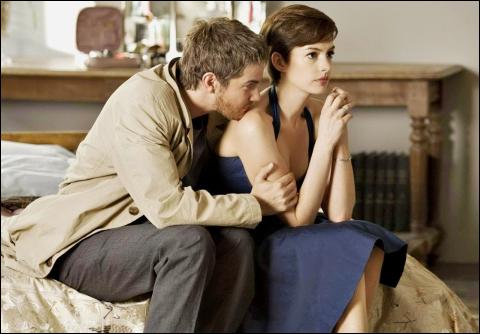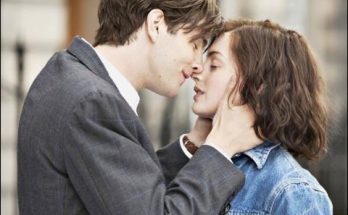Anne Hathaway notes, “Lone is so detail-oriented and so specific; she is involved in everything. The hair, the make-up, the clothes…”
Lone Scherfig confirms, “Shooting One Day was a fantastic challenge for each of the departments. The film opens at daybreak in 1988 and ends at dusk in the summer of 2011, travelling through all the intense, witty, and moving moments in David Nicholls’ story. I felt fortunate and privileged during our summer of work.
“Many members of the crew have lived through the same times and places as our main characters. So the film is packed with subtle layers and authentic details, be it a curtain swaying in a breeze from the Thames river; Emma’s much-too-warm boots; or a track coming from Dexter’s car radio.”
With the story spanning two decades, the time periods would rarely not be referenced, but the march of time needed to be gradual and subtle. Hathaway remembers initially “thinking, ‘Oh, how much fun this is going to be.’ The closer I got to doing it, I realized that it was going to take specific, carefully measured nuances for each year.”
Accordingly, the leading lady spent a lot of time with the design teams working out what her character’s progression should be. She remarks, “We had to decide exactly what Em’s habits were at all different points of her life, and figure out how we were going to reflect them.
“If you’re playing a character at one point and then years later, it’s easy to imagine a host of changes and that you would do something quite dramatic. With this film, everything had to be noticeable but also subtle; you have pockets of growth in your life, and sometimes you have a pivotal year that changes you.”
Hathaway reveals, “With this crew, I felt like I was taken care of all the time – and thank goodness, because of course we didn’t shoot in order; there was one day of filming where I shot four different years…
“We had to calculate every decision. What were Emma’s habits at different points of her life? It wasn’t enough to find ‘a look;’ we had to ask ourselves, ‘Why did she choose this?’ or ‘Where was she when she made the decision to cut her hair off?’”
On the tonsorial tip, Jim Sturgess adds, “By which haircut I was getting, I could just about tell where Dexter was in his life. We spent a lot of time with the hair and make-up and costume departments before we started shooting – and then again on every day of shooting – in order to get all these looks right. “I predict that I look better as Dex at age 43 than I myself will at that age!”
Costume designer Odile Dicks-Mireaux, who was again (after An Education) travelling through time on-screen with director Lone Scherfig, was careful not to plan “a documentary of a whole load of different fashions. First and foremost, we want audiences to be going through the emotional journey with these two believable characters. But because we couldn’t have our extras looking ‘2010,’ you’ll see them in what people were wearing; huge shoulder pads, pleated trousers, and colored jeans.”
Rafe Spall, who plays “Ian, a really bad stand-up comedian” and Emma’s first boyfriend, offers, “I say, bring back the 501 jeans! We’re far enough out of the 1990s now to be able to comment on the decade, and One Day will be one of the first films to capture that. But, seeing all the extras dressed in the ‘90s clothes – wow.”
Turning to the lead characters, Dicks-Mireaux sized them up early and often. She reports, “Dexter, because he has money, makes the obvious choices in fashions. Emma is more complex; at the beginning of the story, she is wearing things that are slightly oldfashioned. Change really comes for her in Paris, later in the story. At every turn, Lone and Anne and I discussed what Emma would wear and what she wouldn’t. We concluded that Emma wasn’t keen on trousers, for instance.
“While we would do many wardrobe fittings, it became apparent that we had to evaluate the complete look; the clothes with the hair and make-up.”
To that end, hair and make-up designer Ivana Primorac is praised by producer Nina Jacobson as being “truly at the top of her field. I was blown away by her ability to capture the fullness of a younger face, and the thinning of the face as one gets a little older.”
Primorac saw the challenge of One Day as “telling this story year by year not only with the sheer number of years covered, but also with two ordinary people. The approach with their looks had to be gentle rather than strong. Given that we meet them in their early 20s, it’s not so much about wrinkles on the skin as it is what they’ve been through; with age comes knowledge and experience, and that’s reflected in people’s faces. I try to make them look ever-so-slightly older in each year. It was especially interesting with Dex, because he learns some things the hard way.
“Lone and Odile and I discussed how even though this is recent history that we all remember, we still had to be objective. Shapes and looks of the times had to be taken into account, so we studied magazines of the period from Vogue to Blitz to The Face, which was especially influential at the time. We also spoke to, and looked at photographs, of real people and friends of friends online. I would make collages on the floor, to see how we could progress. We did dressed-up tests with the actors, and then figured out what we all thought was the best way forward.”
Next Page: Extraordinary Visual Style
Views: 81



